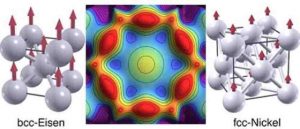
Without a magnetic field life on Earth would be rather uncomfortable: Cosmic particles would pass through our atmosphere in large quantities and damage the cells of all living beings. Technical systems would malfunction frequently and electronic components could be destroyed completely in some cases.
Despite its huge significance for life on our planet, it is still not fully known what creates Earth’s magnetic field. There are various theories regarding its origin, but a lot of experts consider them to be insufficient or flawed. A discovery made by scientists from Würzburg might provide a new explanatory angle. Their findings were published in the current issue of the journal Nature Communications. Accordingly, the key to the effect could be hidden in the special structure of the element nickel.
Contradiction between theory and reality
“The standard models for Earth’s magnetic field use values for the electric and thermal conductivity of the metals inside our planet’s core that cannot square with reality,” Giorgio Sangiovanni says; he is a professor at the Institute for Theoretical Physics and Astrophysics at the University of Würzburg. Together with PhD student Andreas Hausoel and postdoc Michael Karolak, he is in charge of the international collaboration that was published recently. Among the participants are Alessandro Toschi and Karsten Held of TU Wien, who are long-term cooperation partners of Giorgio Sangiovanni, and scientists from Hamburg, Halle (Saale) and Yekaterinburg in Russia.
At Earth’s centre at a depth of about 6,400 km, there is a temperature of 6,300 degrees Celsius and a pressure of about 3.5 million bars. The predominant elements, iron and nickel, form a solid metal ball under these conditions which makes up the inner core of Earth. This inner core is surrounded by the outer core, a fluid layer composed mostly of iron and nickel. Flowing of liquid metal in the outer core can intensify electric currents and create Earth’s magnetic field — at least according to the common geodynamo theory. “But the theory is somewhat contradictory,” Giorgio Sangiovanni says.
Band-structure induced correlation effects
“This is because at room temperature iron differs significantly from common metals such as copper or gold due to its strong effective electron-electron interaction. It is strongly correlated,” he declares. But the effects of electron correlation are attenuated considerably at the extreme temperatures prevailing in Earth’s core so that conventional theories are applicable. These theories then predict a much too high thermal conductivity for iron which is at odds with the geodynamo theory.
With nickel things are different. “We found nickel to exhibit a distinct anomaly at very high temperatures,” the physicist explains. “Nickel is also a strongly correlated metal. Unlike iron, this is not due to the electron-electron interaction alone, but is mainly caused by the special band structure of nickel. We baptised the effect ‘band-structure induced correlation’.” The band structure of a solid is only determined by the geometric layout of the atoms in the lattice and by the atom type.
Iron and nickel in Earth’s core
“At room temperature, iron atoms will arrange in a way that the corresponding atoms are located at the corners of an imaginary cube with one central atom at the centre of the cube, forming a so-called bcc lattice structure,” Andreas Hausoel adds. But as temperature and pressure increase, this structure changes: The atoms move together more closely and form a hexagonal lattice, which physicists refer to as an hcp lattice. As a result, iron looses most of its correlated properties.
But not so with nickel: “In this metal, the atoms are as densely packed as possible in the cube structure already in the normal state. They keep this layout even when temperature and pressure become very large,” Hausoel explains. The unusual physical behaviour of nickel under extreme conditions can only be explained by the interaction of this geometric stability and the electron correlations originating from this geometry. Despite the fact that scientists have neglected nickel so far, it seems to play a major role in Earth’s magnetic field.
Decisive hint from geophysics
The goings-on inside Earth’s core are not the actual focus of research at the Departments of Theoretical Solid-state Physics of the University of Würzburg. Rather Sangiovanni, Hausoel and their colleagues concentrate on the properties of strongly correlated electrons at low temperatures. They study quantum effects and so-called multi-particle effects which are interesting for the next generation of data processing and energy storage devices. Superconductors and quantum computers are the keywords in this context.
Data from experiments are not used in this kind of research. “We take the known properties of atoms as input, include the insights from quantum mechanics and try to calculate the behaviour of large clusters of atoms with this,” Hausoel says. Because such calculations are highly complex, the scientists have to rely on external support such as the SUPERMUC supercomputer at the Leibniz Supercomputing Centre (LRZ) in Garching.
And what’s Earth’s core got to do with this? “We wanted to see how stable the novel magnetic properties of nickel are and found them to survive even very high temperatures,” Hausoel says. Discussions with geophysicists and further studies of iron-nickel alloys have shown that these discoveries could be relevant for what is happening inside Earth’s core.
Reference:
A. Hausoel, M. Karolak, E. Şaşɩoğlu, A. Lichtenstein, K. Held, A. Katanin, A. Toschi, G. Sangiovanni. Local magnetic moments in iron and nickel at ambient and Earth’s core conditions. Nature Communications, 2017; 8: 16062 DOI: 10.1038/ncomms16062
Note: The above post is reprinted from materials provided by University of Würzburg. Original written by Gunnar Bartsch.










